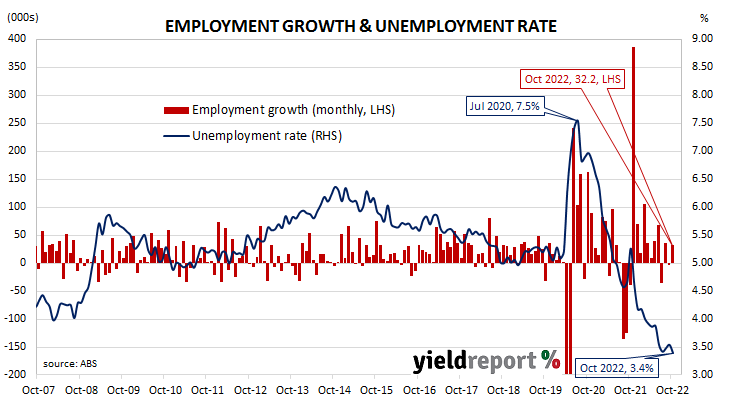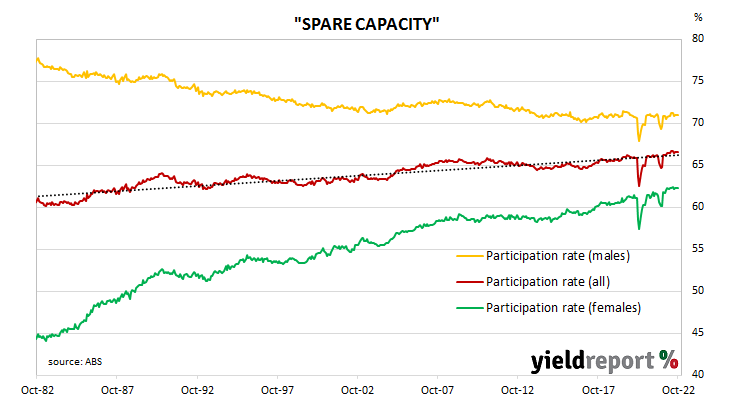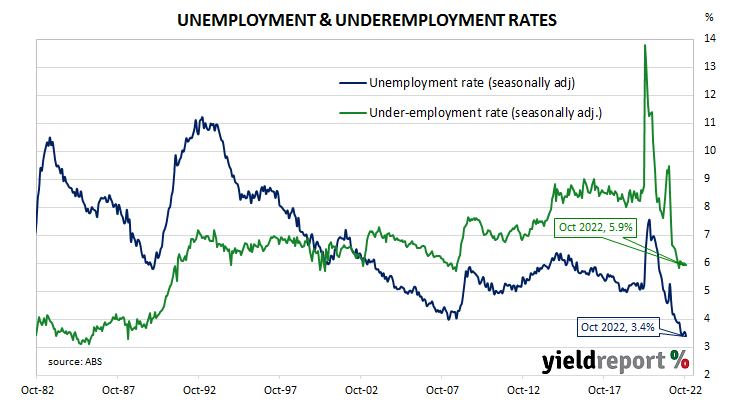Summary: Employment up 32,200 in October, greater than expected; “strong update” despite holidays, sick days, floods; in line with most forward labour demand indicators; participation rate unchanged at 66.5%; jobless rate declines to 3.4%; fewer part-time, more full-time jobs; aggregate work hours up 2.3%; underemployment rate declines to 5.9%.
Australia’s period of falling unemployment came to an end in early 2019 when the jobless rate hit a low of 4.9%. It then averaged around 5.2% through to March 2020, bouncing around in a range from 5.1% to 5.3%. Leading indicators such as ANZ’s Job Ads survey and NAB’s capacity utilisation estimate suggested the unemployment rate would rise in the June 2020 quarter and it did so, sharply. The jobless rate peaked in July 2020 but fell below 7% a month later and has since trended lower.
The latest Labour force figures have now been released and they indicate the number of people employed in Australia according to ABS definitions increased by 32,200 in October. The rise was greater than the 15,000 increase which had been generally expected as well as September’s 3,800 loss.
“It was a strong update even though holidays, sickness and floods continue to hold back the recovery,” said Westpac senior economist Justin Smirk. “Unemployment is now the lowest level since November 1974.”
Domestic Treasury bond yields fell considerably on the day, somewhat in line with the overnight falls of their US Treasury counterparts. By the close of business, the 3-year ACGB yield had lost 7bps to 3.22% while 10-year and 20-year yields each finished 11bps lower at 3.62% and 4.09% respectively.
In the cash futures market, expectations regarding future rate rises softened. At the end of the day, contracts implied the cash rate would rise from the current rate of 2.81% to average 2.98% in December and then increase to an average of 3.19% in February. May 2023 contracts implied a 3.57% average cash rate while August 2023 contracts implied 3.72%.
“This labour print is in line with most forward labour demand indicators, including job ads, employment intentions and unemployment expectations,” observed Morgan Stanley economist Chris Read. “These indicators have levelled off over recent months, although [they] are still universally at very strong levels, with no sign yet of a meaningful reversal coming through.”
The participation rate remained unchanged from September’s revised figure of 66.5% as the total available workforce increased by 11,700 to 14.095 million while the number of unemployed persons decreased by 20,500 to 477,600. As a result, the unemployment rate declined from 3.5% to 3.4%.
The aggregate number of hours worked across the Australian economy increased by 2.3% as 14,900 residents lost part-time positions and 47,200 residents gained full-time positions. On a 12-month basis and after revisions, aggregate hours worked increased by 9.7% as 180,600 more people held part-time positions and 542.3,000 more people held full-time positions than in October 2021.
In recent years, more attention has been paid to the underemployment rate, which is the number of people in work but who wish to work more hours than they do currently. October’s underemployment rate declined from September’s revised rate of 6.0% to 5.9%, just above May’s recent low of 5.8%.
The underutilisation rate, that is the sum of the underemployment rate and the unemployment rate, has a strong correlation with the annual growth rate of the ABS private sector wage index when advanced by two quarters. October’s underutilisation rate of 9.3% corresponds with an annual growth rate of about 4.6%.




